Damage Mechanism and Stress Distribution of Gypsum Rock Pillar Subjected to Blasting Disturbance
Abstract
:1. Introduction
2. Gypsum Rock Damage with Blasting
2.1. Test Design
2.2. Testing Parameter
3. Results
3.1. Wave Velocity Change
- (1)
- As the number of blasting tests increased, the wave velocity of Sections 1–4 in the horizontal direction decreased in general. The vertical wave velocity of Sections 1–4 fluctuated within a certain range in the early stage of the blasting stage; however, it increased slightly in the later stage of the blasting test. The increase or decrease in the wave velocity of each section indicated fluctuation, and the fluctuating range of the vertical section was greater than that of the horizontal section; however, the wave velocity change did not indicate a clear linear relationship as the number of blasting tests increased.
- (2)
- The wave velocity of the horizontal section increased, within several previous tests (3–4 times), which was primarily due to the closure and compaction of internal microstructures of gypsum rocks caused by blasting disturbance, and the integrity of gypsum rock improved. The vertical monitoring section did not indicate this feature.
- (3)
- As the depth of the monitoring holes increased, the wave velocity reduction range of the horizontal section increased in general, although fluctuations were observed as well. The wave velocity of the vertical section as the depth of the monitoring holes increased fluctuated significantly and did not exhibit regularity.
3.2. Damage Degree
4. Stress Distribution and Evolution of Gypsum Rock Pillars Subjected to Disturbances
4.1. Numerical Simulation Calculation Model
4.2. Stress Distribution
4.3. Stress Evolution
- (1)
- As the disturbance strength increased, the stress of the gypsum rock pillars increased gradually. Meanwhile, as the disturbance distance increased, the stress of the gypsum rock pillars decreased gradually; however, the abovementioned stress was greater than the original static stress. The gypsum rock pillars next to the point where disturbance was applied not only indicated an increase in the vertical stress, but also a high tensile stress at the edge of the gypsum rock pillars. However, the tensile stress was much smaller than the vertical stress.
- (2)
- The first row of pillars A1j and the third column of pillars Ai3 were the most affected by disturbance. When the disturbance strength exceeded 6 MPa, the stress increased significantly. The greater the distance from the centreline of the disturbance application point, the less significant was the change in the gypsum rock stress, i.e., the stress change of the gypsum rock pillars indicated Aij < Aij + 1 and Ai + 1j < Aij.
- (3)
- As the disturbance distance increased, no abrupt significant changes were observed in terms of the pillar stress, and the overall relationship between them can be regarded as linear. However, the linear relationship between disturbance strength and stress was not evident. During the entire disturbance calculation process, all gypsum rock pillar stresses did not exceed its ultimate compressive strength of 24.12 MPa.
5. Discussion
- (1)
- The size of the gypsum rock pillar in blasting test and numerical simulation is hard to design as the same. If the size of the pillar is too small in the blasting test, the pillar will fail with one or two blasts, and a multi-blasting test cannot be carried out. If the size of the pillar in numerical simulation is similar to the blasting test, it will be inconsistent with the actual mining situation.
- (2)
- Gypsum rock is different to other rocks with a significant feature of creep. It is a hard work to construct a suitable constitutive model for gypsum. Although the model of numerical simulation is extremely similar to gypsum rock, it is still different to gypsum mined gob. So, it is meaningless to analyse the relationship between blasting test results and numerical simulation results.
- (3)
- At present, it is difficult to represent rock damage degree with stress. The conditions of blasting test and numerical simulation are different, including boundary condition, blasting and disturbance strength. However, disturbance stress is the initial reason to induce gypsum damage and failure. So, we studied the issue in two parts.
6. Conclusions
- (1)
- In the blasting test, as the number of blasting tests increased, the damage degree of the gypsum rock pillar along the horizontal direction increased, with a maximum damage rate of 7.82%. As the blasting-hole depth increased, the damage degree increased in general, but with significant fluctuations. The damage degree along the vertical direction eventually indicated a negative increase, with a maximum value of 3.52%. In the blasting test, the damage degree of the gypsum rock pillar in the horizontal direction test was greater than that in the vertical direction.
- (2)
- In disturbance numerical simulation calculations, as the disturbance strength increased, the stress of the gypsum rock pillars increased, although no clear linear relationship was observed between them. As the disturbance distance increased, the stress of the gypsum rock pillars decreased gradually, and a linear relationship was observed between them. However, the abovementioned stress was greater than the original static stress. Pillars next to the disturbance application point exhibited clear obvious tensile stress areas at the edges, although they were comparatively lower. During the disturbance calculation process, the stresses of all gypsum rock pillars did not exceed the ultimate compressive strength.
- (3)
- In the blasting test, the blasting strength was low, and the number of tests was small; however, the maximum damage of the gypsum rock pillar reached 7.82%. This proves that blasting and disturbance significantly damaged gypsum rocks, and that they were primary factors inducing gypsum rock pillar failure and gypsum mined-gob collapse.
- (4)
- The damage mechanism of gypsum rock pillars subjected to blasting disturbance was investigated, based on blasting tests and disturbance numerical simulation calculations, respectively. However, the correlation between blasting tests results and numerical simulation results was poor and the reason was discussed.
Author Contributions
Funding
Institutional Review Board Statement
Informed Consent Statement
Data Availability Statement
Conflicts of Interest
References
- Castellanza, R.; Nova, R.; Orlandi, G. Evaluation and remediation of an abandoned gypsum mine. J. Geotech. Geoenviron. Eng. 2010, 136, 629–639. [Google Scholar] [CrossRef]
- Sadeghiamirshahidi, M.; Vitton, S.J. Laboratory study of gypsum dissolution rates for an abandoned underground mine. Rock Mech. Rock Eng. 2019, 52, 2053–2066. [Google Scholar] [CrossRef]
- Xia, K.; Chen, C.; Yang, K.; Sun, C.; Liu, X.; Zhou, Y. Influence of relative humidity on the non-linear failure and stability of gypsum mines. Eur. J. Environ. Civ. Eng. 2020, 3, 1–26. [Google Scholar] [CrossRef]
- Chen, M.; Lu, W.B.; Yan, P.; Hu, Y.G. Blasting excavation induced damage of surrounding rock masses in deep-buried tunnels. KSCE J. Civ. Eng. 2016, 20, 933–942. [Google Scholar] [CrossRef]
- Ji, L.; Zhou, C.; Lu, S.; Jiang, N.; Li, H. Modeling study of cumulative damage effects and safety criterion of surrounding rock under multiple full-face blasting of a large cross-section tunnel. Int. J. Rock Mech. Min. 2021, 147, 104882. [Google Scholar] [CrossRef]
- Singh, R.K.; Sawmliana, C.; Hembram, P. Damage threat to sensitive structures of a thermal power plant from hard rock blasting operations in track hopper area: A case study. Int. J. Prot. Struct. 2020, 11, 3–22. [Google Scholar] [CrossRef]
- Amiri, M.; Hasanipanah, M.; Bakhshandeh Amnieh, H. Predicting ground vibration induced by rock blasting using a novel hybrid of neural network and itemset mining. Neural Comput. Appl. 2020, 32, 14681–14699. [Google Scholar] [CrossRef]
- Wang, S.; Zhu, G.; Zhang, K.; Yang, L. Study on characteristics of mining earthquake in multi coal seam mining under thick and hard strata in high position. Shock Vib. 2021, 2021, 6675089. [Google Scholar] [CrossRef]
- Fang, Z.B.; Yan, Q.; Sun, X.D.; Fu, D.; Zhang, X.X.; Liu, X.; Qi, N. Dynamic response and perturbation design of surrounding rock in blasting construction of small radius spiral tunnel. IOP Conf. Ser. Earth Environ. Sci. 2020, 570, 52057. [Google Scholar] [CrossRef]
- Ji, S.; Zhang, J.; Pan, R.; Karlovšek, J. Local acceleration monitoring and its application in physical modelling of underground mining. Int. J. Rock Mech. Min. 2020, 128, 104282. [Google Scholar] [CrossRef]
- Kraszewski, M. The influence of para-seismic vibrations induced by blasting works on construction structures: A case study of the ABC opencast gypsum mine. IOP Conf. Ser. Earth Environ. Sci. 2019, 261, 12021. [Google Scholar] [CrossRef]
- Xue, Y.; Xu, T.; Zhu, W.; Heap, M.J.; Zheng, H.; Wang, X. Full-field quantification of time-dependent and -independent deformation and fracturing of double-notch flawed rock using digital image correlation. Geomech. Geophys. Geo. 2021, 7, 100. [Google Scholar] [CrossRef]
- Gómez, S.; Sanchidrián, J.A.; Segarra, P. Near-field vibration from blasting and rock damage prediction with a full-field solution. Int. J. Rock Mech. Min. 2020, 134, 104357. [Google Scholar] [CrossRef]
- Pan, Q.; Zhang, J.; Zheng, S. Study on distribution characteristics of damage range along smooth blasting hole based on PPV. Math Probl. Eng. 2020, 2020, 4785839. [Google Scholar] [CrossRef]
- Saadatmand Hashemi, A.; Katsabanis, P. The effect of stress wave interaction and delay timing on blast-induced rock damage and fragmentation. Rock Mech Rock Eng. 2020, 53, 2327–2346. [Google Scholar] [CrossRef]
- Xiaolong, S.; Wenxue, G.A.; Jinming, J.I.; Mingban, Y.E.; Dengjie, Z. Investigation of the fractal characteristics of cumulative damage to tunnel surrounding rock under blasting vibration. IOP Conf. Ser. Earth Environ. Sci. 2020, 570, 42036. [Google Scholar] [CrossRef]
- Liu, Z.; Zheng, H.; Li, M. Experimental research on creep failure characteristics of gypsum rock based on rock longitudinal wave velocity. Geotech. Geol. Eng. 2019, 37, 1515–1522. [Google Scholar] [CrossRef]
- Xia, K.; Chen, C.; Zhou, Y.; Liu, X.; Zheng, Y.; Pan, Y. Catastrophe instability mechanism of the pillar-roof system in gypsum mines due to the influence of relative humidity. Int. J. Geomech. 2019, 19, 6019004. [Google Scholar] [CrossRef]
- Xu, X.; Cui, X.; Liu, X.; Tang, Q.; Zhang, X.; Sun, Y. Damage analysis of soaking gypsum and safety evaluation of goaf: Based on energy dissipation theory. Geotech. Geol. Eng. 2020, 38, 6177–6188. [Google Scholar] [CrossRef]
- Shun, P.; Xu, X.; Zhou, Y.; Zang, G.; Wang, J. Investigation of instability and blasting caving technology of composite support structure in the goaf of gypsum mine. Geotech. Geol. Eng. 2021, 39, 4377–4391. [Google Scholar] [CrossRef]
- Hogan, J.D.; Boonsue, S.; Spray, J.G.; Rogers, R.J. Micro-scale deformation of gypsum during micro-indentation loading. Int. J. Rock Mech. Min. 2012, 54, 140–149. [Google Scholar] [CrossRef]
- Ma, H.; Song, Y.; Chen, S.; Yin, D.; Zheng, J.; Shen, F.; Li, X.; Ma, Q. Experimental investigation on the mechanical behavior and damage evolution mechanism of water-immersed gypsum rock. Rock Mech. Rock Eng. 2021, 54, 4929–4948. [Google Scholar] [CrossRef]
- Ji, S.; He, H.; Karlovšek, J. Application of superposition method to study the mechanical behaviour of overlying strata in longwall mining. Int. J. Rock Mech. Min. 2021, 146, 104874. [Google Scholar] [CrossRef]
- Meng, T.; Hu, Y.; Fang, R.; Fu, Q.; Yu, W. Weakening mechanisms of gypsum interlayers from Yunying salt cavern subjected to a coupled thermo-hydro-chemical environment. J. Nat. Gas Sci. Eng. 2016, 30, 77–89. [Google Scholar] [CrossRef]
- Xue, Y.; Xu, T.; Wasantha, P.L.P.; Yang, T.; Fu, T. Dynamic disaster control of backfill mining under thick magmatic rock in one side goaf: A case study. J. Cent. South Univ. 2020, 27, 3103–3117. [Google Scholar] [CrossRef]
- Meng, T.; Hu, Y.; Fang, R.; Kok, J.; Fu, Q.; Feng, G. Study of fracture toughness and weakening mechanisms in gypsum interlayers in corrosive environments. J. Nat. Gas Sci. Eng. 2015, 26, 356–366. [Google Scholar] [CrossRef]

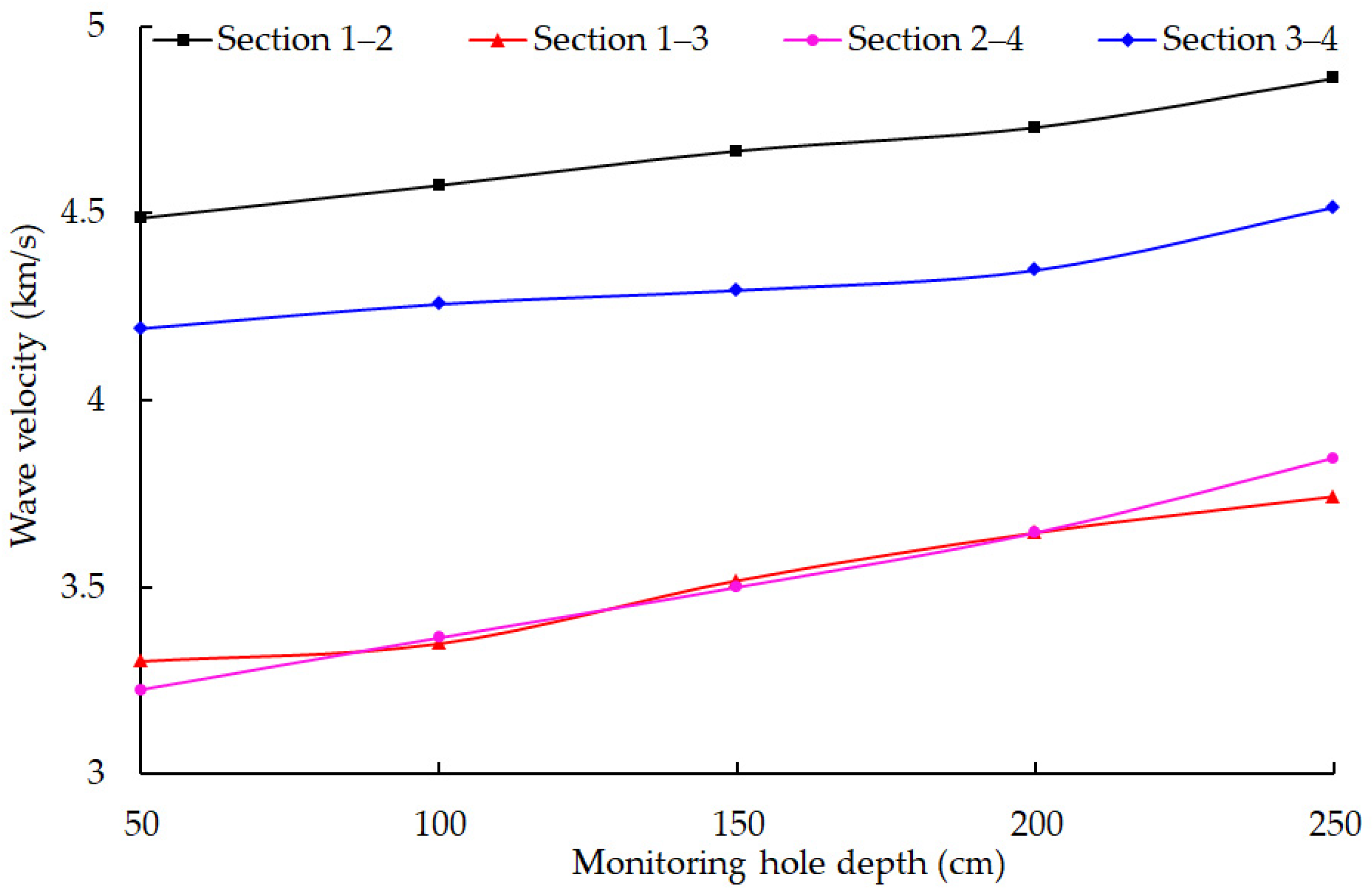
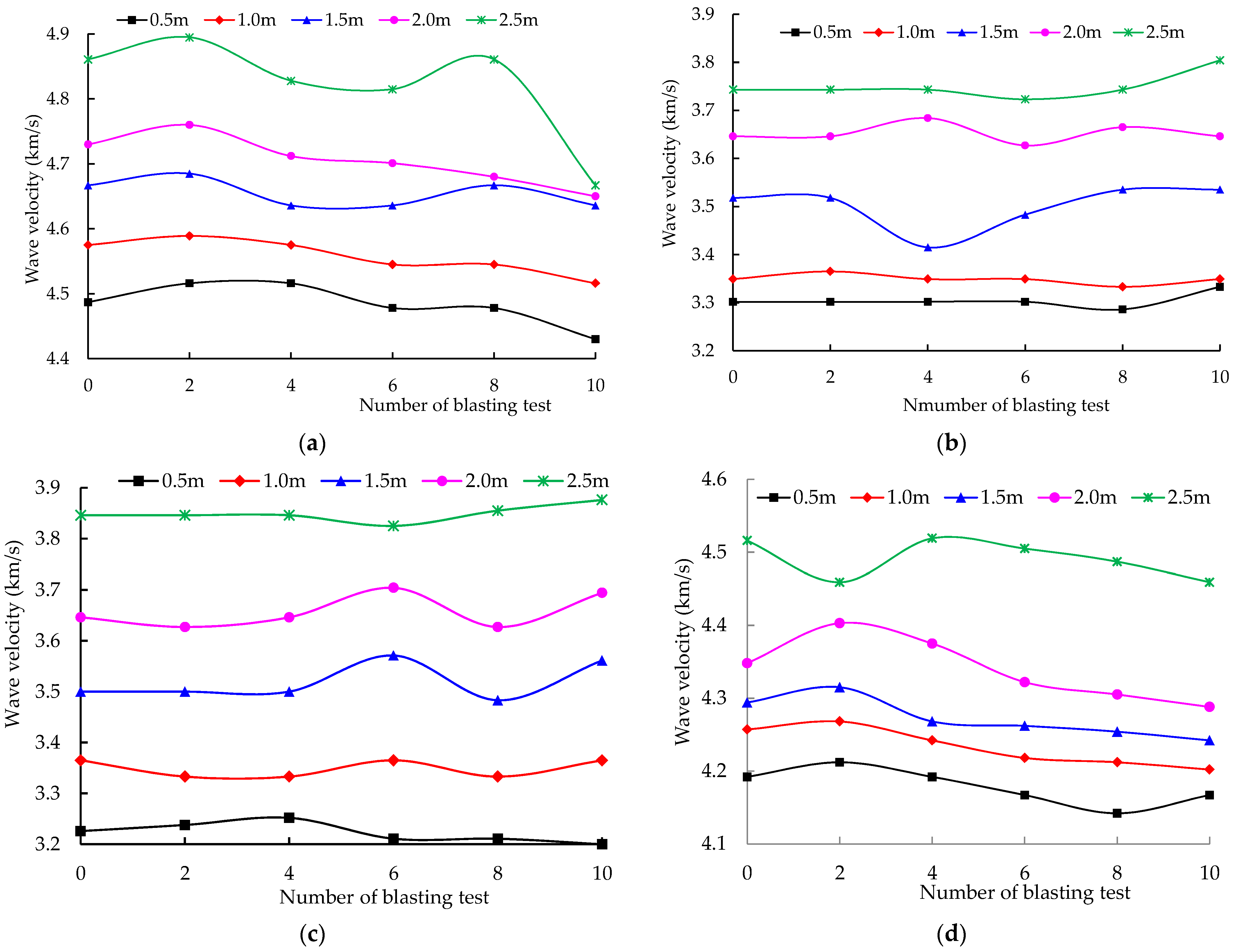

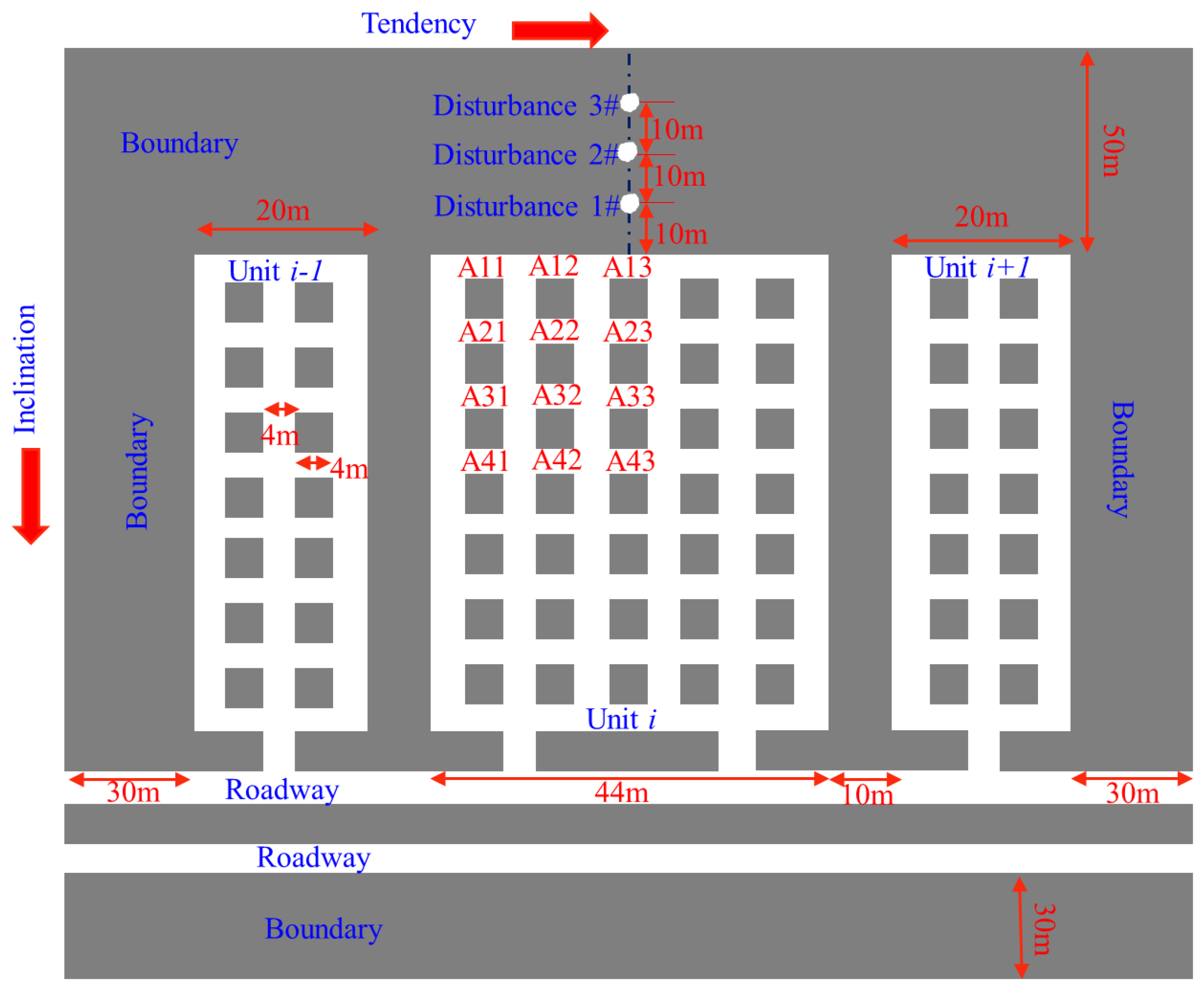
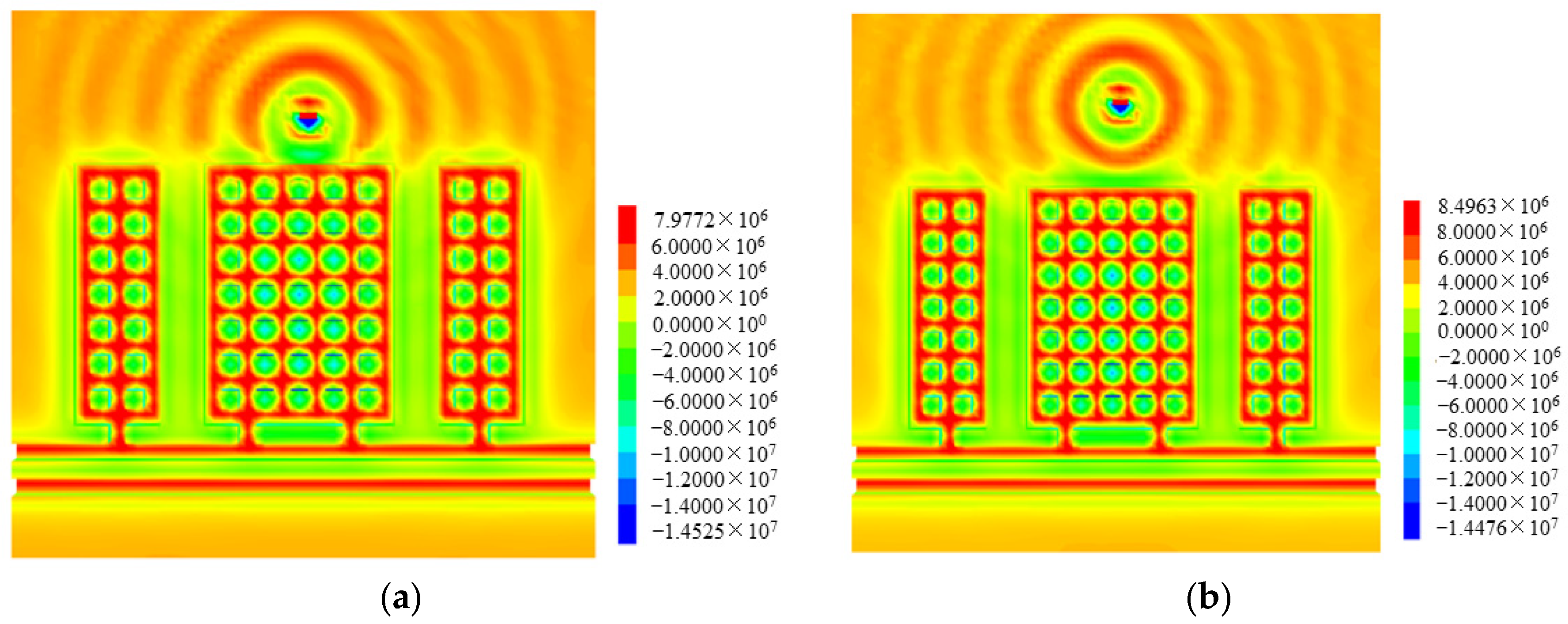
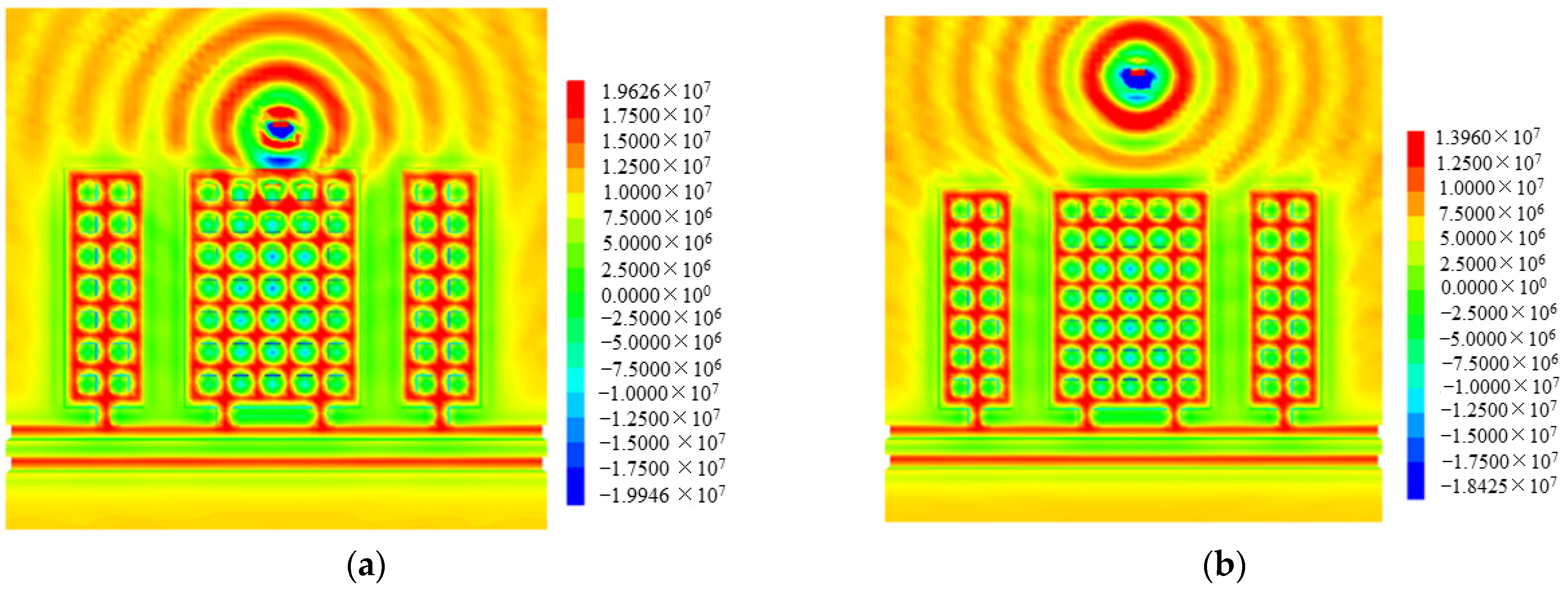
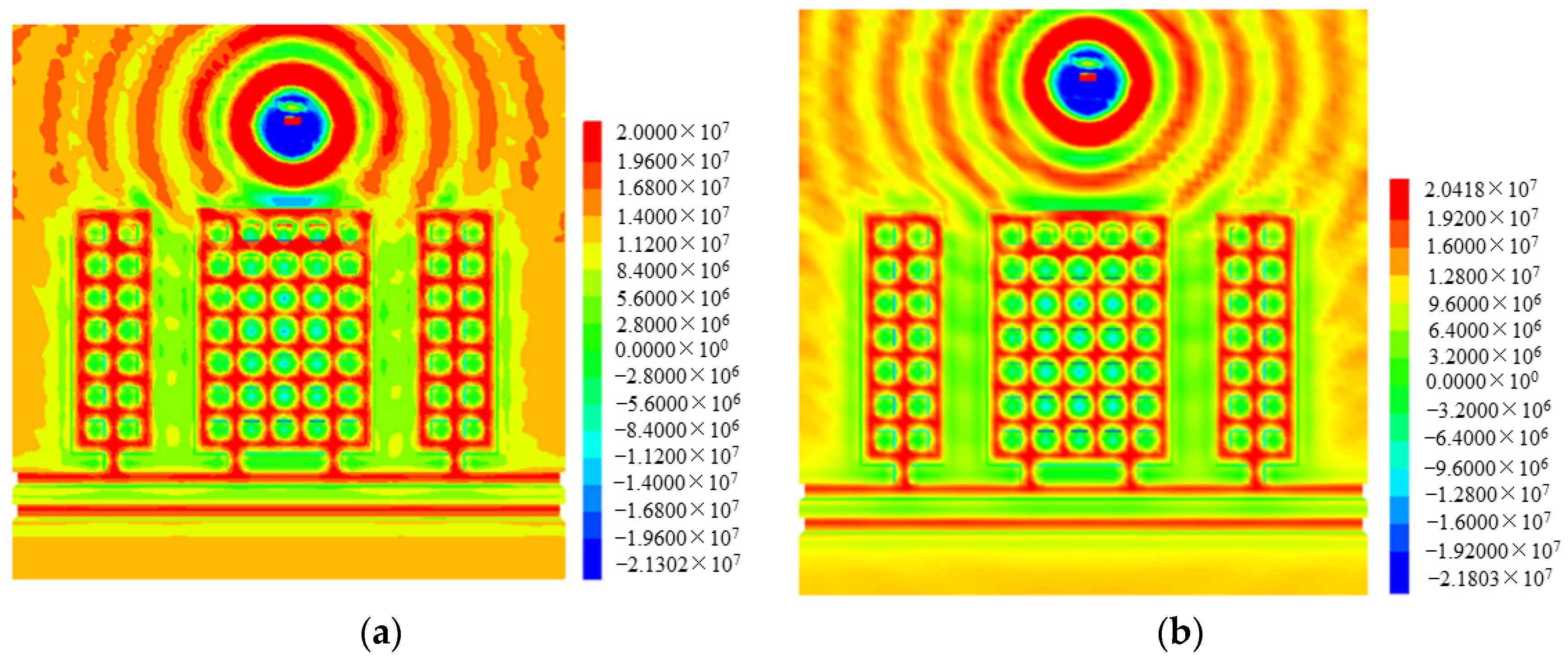

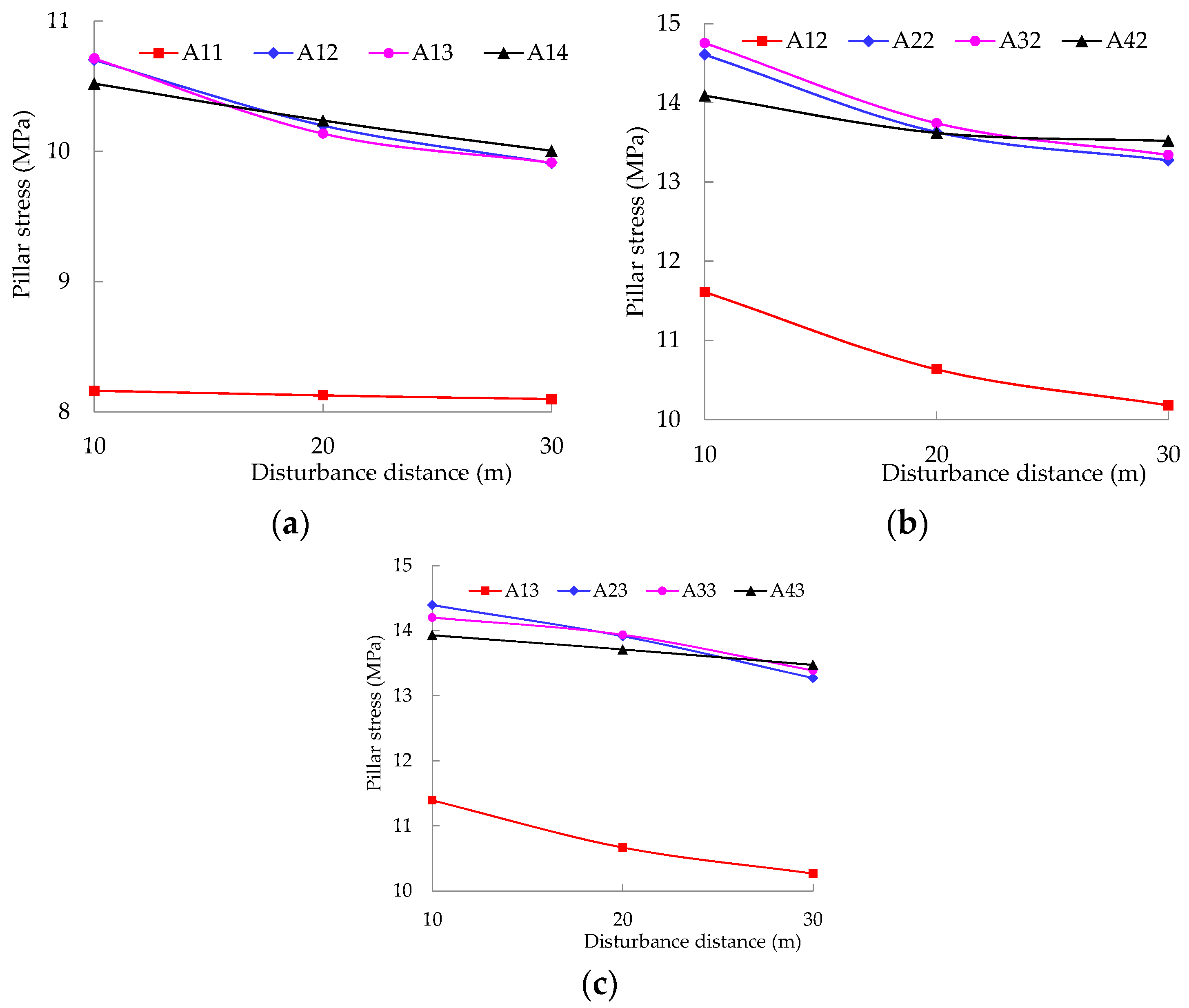
| Rock Formation Name | Thickness (m) | Elastic Modulus (GPa) | Shear Modulus (GPa) | Cohesion (MPa) | Internal Friction (°) | Tensile Strength (MPa) |
|---|---|---|---|---|---|---|
| Gypsum-mudstone | 4 | 5.22 | 3.31 | 5.87 | 41.0 | 1.10 |
| Gypsum-marl | 6 | 3.64 | 1.45 | 3.61 | 43.0 | 1.20 |
| Mudstone | 6 | 4.32 | 2.41 | 1.23 | 18.2 | 2.61 |
| Silty-mudstone | 4 | 6.25 | 2.76 | 1.64 | 37.5 | 1.37 |
| Marl layer | 12 | 4.68 | 2.57 | 1.51 | 23 | 1.92 |
| Mudstone | 2 | 4.32 | 2.41 | 1.23 | 18.2 | 2.61 |
| Gypsum-mudstone | 2 | 5.22 | 3.31 | 5.87 | 41.0 | 1.10 |
| Gypsum-marl | 2 | 3.64 | 1.45 | 3.61 | 43.0 | 1.20 |
| II-1 layer | 6 | 1.79 | 2.48 | 1.62 | 32.0 | 2.41 |
| Gypsum-marl | 4 | 3.64 | 1.45 | 3.61 | 43.0 | 1.20 |
| II-2 layer | 6 | 1.79 | 2.48 | 1.62 | 32.0 | 2.41 |
| Marl layer | 10 | 4.68 | 2.57 | 1.51 | 23.0 | 1.92 |
Publisher’s Note: MDPI stays neutral with regard to jurisdictional claims in published maps and institutional affiliations. |
© 2022 by the authors. Licensee MDPI, Basel, Switzerland. This article is an open access article distributed under the terms and conditions of the Creative Commons Attribution (CC BY) license (https://creativecommons.org/licenses/by/4.0/).
Share and Cite
Wang, S.; Liu, Z.; Zhang, K.; Zheng, H. Damage Mechanism and Stress Distribution of Gypsum Rock Pillar Subjected to Blasting Disturbance. Sustainability 2022, 14, 5010. https://doi.org/10.3390/su14095010
Wang S, Liu Z, Zhang K, Zheng H. Damage Mechanism and Stress Distribution of Gypsum Rock Pillar Subjected to Blasting Disturbance. Sustainability. 2022; 14(9):5010. https://doi.org/10.3390/su14095010
Chicago/Turabian StyleWang, Shuli, Zhihe Liu, Kaizhi Zhang, and Huaichang Zheng. 2022. "Damage Mechanism and Stress Distribution of Gypsum Rock Pillar Subjected to Blasting Disturbance" Sustainability 14, no. 9: 5010. https://doi.org/10.3390/su14095010
APA StyleWang, S., Liu, Z., Zhang, K., & Zheng, H. (2022). Damage Mechanism and Stress Distribution of Gypsum Rock Pillar Subjected to Blasting Disturbance. Sustainability, 14(9), 5010. https://doi.org/10.3390/su14095010





